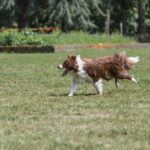“How do I train my dog not to chase chickens? This is a common question among dog owners, especially those who also raise poultry. Understanding why dogs have the instinct to chase chickens is the first step in effectively training them to resist this behavior. In this article, we will explore the reasons why dogs are prone to chasing chickens and provide practical tips on how to train them to coexist peacefully with your feathered friends”.
The instinct to chase small animals, such as chickens, is deeply rooted in a dog’s natural predatory behavior. Dogs are descended from wolves, which were predators by nature. This instinct is not inherently malicious; rather, it is a leftover survival trait that drives dogs to pursue anything that triggers their prey drive. However, it can pose serious risks to the safety and well-being of livestock and wildlife.
Training your dog not to chase chickens is not only important for the safety of your poultry, but also for the overall harmony of your household. Establishing boundaries and creating a safe space for your chickens can help prevent any potential altercations between your dog and livestock. Positive reinforcement training, leash training, consistency, supervision, and correction are all essential components of successfully modifying your dog’s behavior.
By understanding the instinct behind dogs’ propensity to chase chickens and implementing effective training techniques, you can create a peaceful environment where both your canine companion and feathered friends can coexist harmoniously. In the following sections of this article, we will delve deeper into these topics and provide practical guidance on how to train your dog not to chase chickens.
The Importance of Training
Understanding the natural instincts of dogs is crucial in preventing any harm to livestock and wildlife, particularly when it comes to their propensity to chase chickens. It’s important for dog owners to recognize that chasing behavior in dogs is often a result of their predatory nature, and not a deliberate attempt to cause harm. However, this behavior can be dangerous for the chickens, as well as other small animals and birds on your property.
To prevent any potential harm to your chickens and other wildlife, training your dog not to chase them is essential. By doing so, you can create a safe environment where both your pets and livestock can coexist peacefully. Moreover, training your dog not to chase chickens also promotes responsible pet ownership and ensures the safety of all animals under your care.
To effectively train your dog not to chase chickens, it’s crucial to establish clear boundaries and consistently reinforce positive behavior. Whether it involves leash training or positive reinforcement techniques, investing the time and effort into properly training your dog will ultimately lead to a harmonious cohabitation between your pets and livestock.
- Introduce daily training routines
- Use positive reinforcement methods such as treats and rewards
- Implement consistent correction of chasing behavior
Establishing Boundaries
Understanding the natural instinct of dogs to chase chickens is crucial when it comes to training them not to engage in this behavior. It’s important to remember that dogs are predators by nature, and their chasing behavior is a manifestation of this instinct. For centuries, dogs have been bred for specific purposes such as herding or hunting, so chasing small animals like chickens comes naturally to them. Understanding this instinct can help you approach training with empathy and patience.
To create a safe space for your chickens, consider implementing physical barriers such as fencing or netting around their living area. This will not only protect the chickens from potential harm but also provide a visual boundary for your dog.
Additionally, providing sufficient exercise and mental stimulation for your dog can help reduce the likelihood of them engaging in chasing behavior. A well-exercised and mentally stimulated dog is less likely to seek out alternative sources of entertainment, such as chasing chickens.
Another important aspect of establishing boundaries for your chickens is proper socialization and interaction between the dogs and chickens. Supervised interactions can help the dog understand that the chickens are part of their pack, which can decrease their predatory instincts towards them over time. Making sure that your dog understands basic obedience commands like “leave it” or “stay” can also be an essential part of creating a safe space for your chickens.
| Training Tips | Data |
|---|---|
| Physical barriers | Implement fencing or netting around chicken area |
| Socialization | Supervised interactions between dogs and chickens |
| Obedience Training | Teaching basic commands like “leave it” or “stay” |
Positive Reinforcement Training
Choosing the Right Treats
When implementing positive reinforcement training, it’s important to select treats that are highly appealing to your dog. Opt for small, soft treats that can be easily and quickly consumed, as this allows for rapid reinforcement of desired behavior. Some examples of suitable treats include bits of cooked chicken, cheese, or commercial dog treats with a strong scent.
Timing and Consistency
To effectively deter chasing behavior, it’s crucial to offer the treat immediately after the dog has made the choice not to pursue the chickens. Providing the reward promptly reinforces the desired behavior and reinforces the idea that not chasing chickens results in positive recognition. Consistency is also key in positive reinforcement training – every time your dog refrains from chasing chickens, they should receive a treat.
Progressive Reinforcement
As your dog begins to associate not chasing chickens with receiving tasty rewards, you can gradually reduce their frequency. Over time, continue to reward them intermittently for making the right choices.
This process helps solidify their understanding that resisting the urge to chase chickens will result in positive outcomes while slowly reducing their dependence on treats. With patience and consistency, positive reinforcement training can effectively deter a dog from chasing chickens and create a safe environment for all animals on your property.
Leash Training
When it comes to training your dog not to chase chickens, leash training can be an effective tool in teaching your dog to respect the space of your livestock. Using a long leash, you can allow your dog to roam within the vicinity of the chickens while still being under your control. This provides an opportunity for positive reinforcement training, as you can reward your dog for calming behaviors around the chickens.
It’s important to start leash training in a controlled environment, such as a fenced area or enclosed chicken coop. Begin by allowing your dog to observe the chickens from a distance while on the leash.
Whenever your dog shows signs of calm behavior, such as sitting or laying down without fixating on the chickens, be sure to reward them with treats and verbal praise. Gradually decrease the distance between your dog and the chickens as they exhibit more control and calmness.
Consistency is key when it comes to leash training. Make sure to incorporate regular sessions into your daily routine, gradually increasing the exposure time and decreasing reliance on treats as your dog becomes more accustomed to respecting the space of the chickens. With patience and dedication, many dogs can learn to coexist peacefully with chickens through effective leash training.
| Leash Training Tips | Importance |
|---|---|
| Start in a controlled environment | To create a safe learning space for both dogs and chickens |
| Be consistent with daily sessions | Repetition helps reinforce positive behavior |
| Reward calm behavior with treats | Positive reinforcement encourages desired actions |
Consistency Is Key
Training your dog not to chase chickens requires consistent and ongoing effort. By establishing a daily training routine, you can effectively teach your dog to respect the boundaries set for the safety of both the chickens and your furry friend.
Here are some tips for implementing a daily training routine:
- Set aside dedicated time each day for training sessions. Consistency is key, so aim to work with your dog at the same time every day.
- Start with short, frequent training sessions. Dogs respond well to regular, brief lessons rather than long, infrequent ones.
- Use positive reinforcement techniques such as treats and rewards to encourage desired behavior. When your dog shows restraint around the chickens, be sure to offer plenty of praise and a tasty treat.
- Be patient and persistent. It may take time for your dog to fully grasp the concept of not chasing chickens, so consistency in your approach is vital.
By implementing a daily training routine that focuses on positive reinforcement and consistency, you can effectively teach your dog to coexist peacefully with chickens. Remember that every dog is different, so be patient and stay committed to the process. Consistency will pay off in the long run as you work towards creating a harmonious environment for both your beloved pet and your feathered friends.
Supervision and Correction
Implementing Real-Time Correction
When it comes to correcting chasing behavior in real-time, it’s important to act quickly and decisively. If you see your dog exhibiting signs that they are about to chase or are actively chasing chickens, it’s crucial to intervene immediately. Use a firm and commanding tone to give the “no” command and redirect your dog’s attention back to you.
Using Positive Reinforcement
In addition to issuing a correction, it’s also beneficial to use positive reinforcement during real-time interventions. Once your dog has stopped chasing the chickens and redirected their attention, be sure to praise and reward them for obeying your command. This will help them understand that listening to you is more beneficial than chasing after the chickens.
Consistency in Corrections
Consistency is key when it comes to correcting chasing behavior in real-time. Every time your dog attempts to chase or does chase the chickens, you must respond with the same level of correction and redirection. This consistent approach will help your dog understand that this behavior is never acceptable, regardless of the circumstances.
By implementing these strategies for supervising and correcting chasing behavior in real-time, you can effectively communicate with your dog that chasing chickens is not acceptable. With patience and persistence, you can work towards training your dog to coexist peacefully with your backyard flock.
Seeking Professional Help
If despite your best efforts, your dog still exhibits chasing behavior towards chickens, seeking professional help may be the next step. Professional dog trainers and animal behaviorists have the knowledge and experience to address challenging behaviors effectively. They can provide personalized guidance and training techniques tailored to your dog’s individual needs.
When choosing a professional trainer or behaviorist, it is important to do thorough research and ask for recommendations from reliable sources. Look for someone who specializes in working with animals that exhibit predatory behaviors. It is essential to find a trainer who uses positive reinforcement methods rather than employing harsh or punitive techniques.
During the training process, the professional will assess your dog’s behavior, identify triggers for chasing, and develop a customized training plan. They may also provide guidance on how to properly socialize your dog with chickens in a controlled environment.
With their expertise, they can help you tackle the underlying reasons for your dog’s chasing behavior and work towards successfully modifying it. A professional can also offer support and guide you through any setbacks that may occur during the training process.
Seeking professional help does not indicate failure as a pet owner but rather demonstrates your commitment to ensuring the safety of both your chickens and your beloved canine companion. With expert guidance, you can increase the likelihood of breaking your dog’s chase instinct while fostering a harmonious relationship between them and your feathered friends.
Case Studies
In conclusion, training a dog not to chase chickens is important for the safety of both the chickens and the dog. Understanding the instinct behind why dogs chase chickens is the first step in effectively training them not to do so. By establishing boundaries and creating a safe space for chickens, pet owners can help prevent chasing behavior. Positive reinforcement training, using treats and rewards, can be an effective way to deter chasing behavior in dogs.
Leash training is another important aspect of teaching a dog to respect chickens’ space. By implementing a daily training routine and being consistent in training methods, pet owners can greatly reduce their dog’s inclination to chase chickens. Additionally, supervising the dog and correcting chasing behavior in real-time can reinforce the training and discourage this behavior.
For those struggling with training their dog not to chase chickens, seeking professional help is important. Dog trainers or animal behavioral specialists can provide guidance on how to effectively train a dog and address any challenging behaviors.
Ultimately, success stories of dogs that have been successfully trained not to chase chickens serve as inspiration for pet owners who may be struggling with this issue. With patience, dedication, and the right approach, it is possible to train a dog not to chase chickens and live harmoniously with livestock and wildlife.
Frequently Asked Questions
How Do I Stop My Dog From Chasing Chickens?
To stop your dog from chasing chickens, it’s important to first understand why they are doing it. Some dogs have a strong prey drive and see chickens as something to chase. One approach is to work on obedience training with your dog, teaching them commands like “leave it” and “stay.”
You can also reinforce positive behavior around chickens by rewarding your dog when they ignore the birds. Additionally, using a leash or a long line during chicken encounters can help you maintain control and redirect your dog’s attention.
Is It Normal for Dogs to Chase Chickens?
It is normal for some dogs to chase chickens due to their natural instincts and prey drive. While many breeds have been domesticated over time, some still retain their instincts to chase small animals like chickens. However, not all dogs will exhibit this behavior, as it depends on their breed, individual personality, and previous experiences with poultry.
How Do I Train My Dog to Leave Chickens Alone?
Training your dog to leave chickens alone requires patience and consistency. Start by exposing your dog to the chickens in a controlled environment and teach them commands such as “leave it” or “stay.” Use positive reinforcement techniques like treats or praise when your dog follows these commands around the chickens.
Gradually increase the level of distraction while maintaining control of the situation until your dog learns to ignore the birds. Remember that this process may take time and repeated training sessions before your dog fully understands how to behave around chickens.

Welcome to the blog! I am a professional dog trainer and have been working with dogs for many years. In this blog, I will be discussing various topics related to dog training, including tips, tricks, and advice. I hope you find this information helpful and informative. Thanks for reading!





